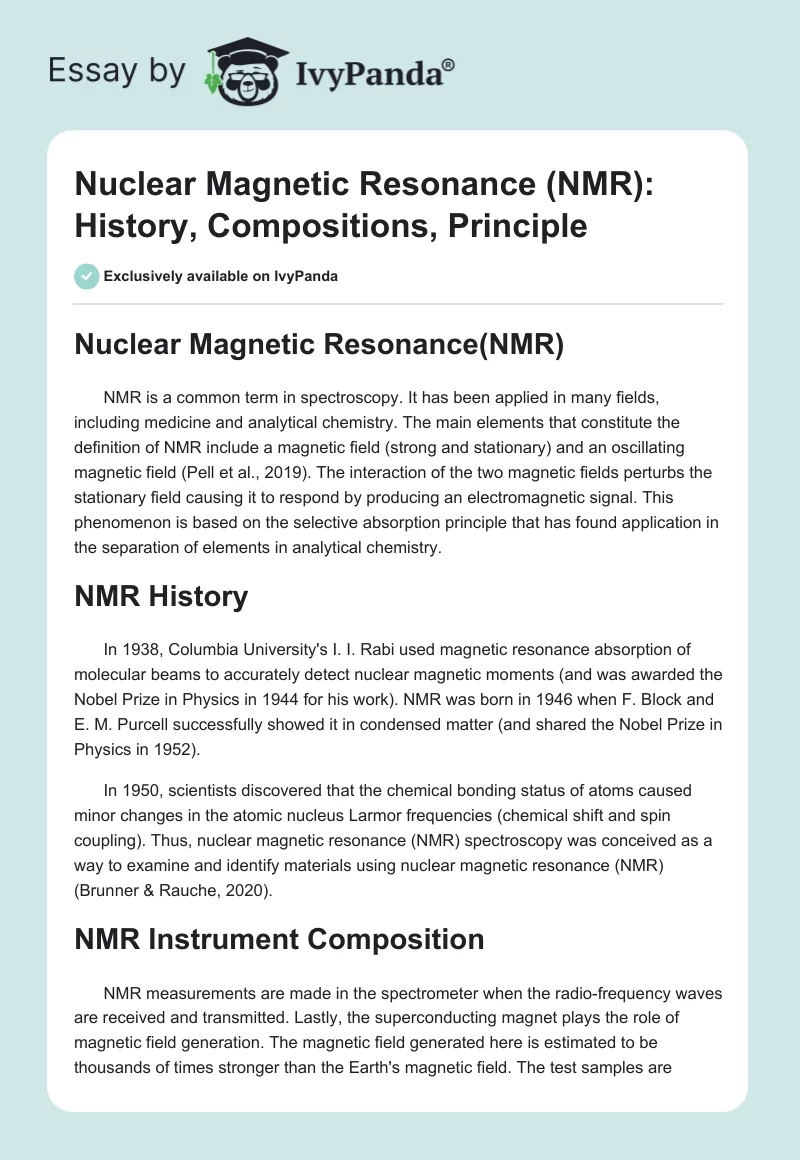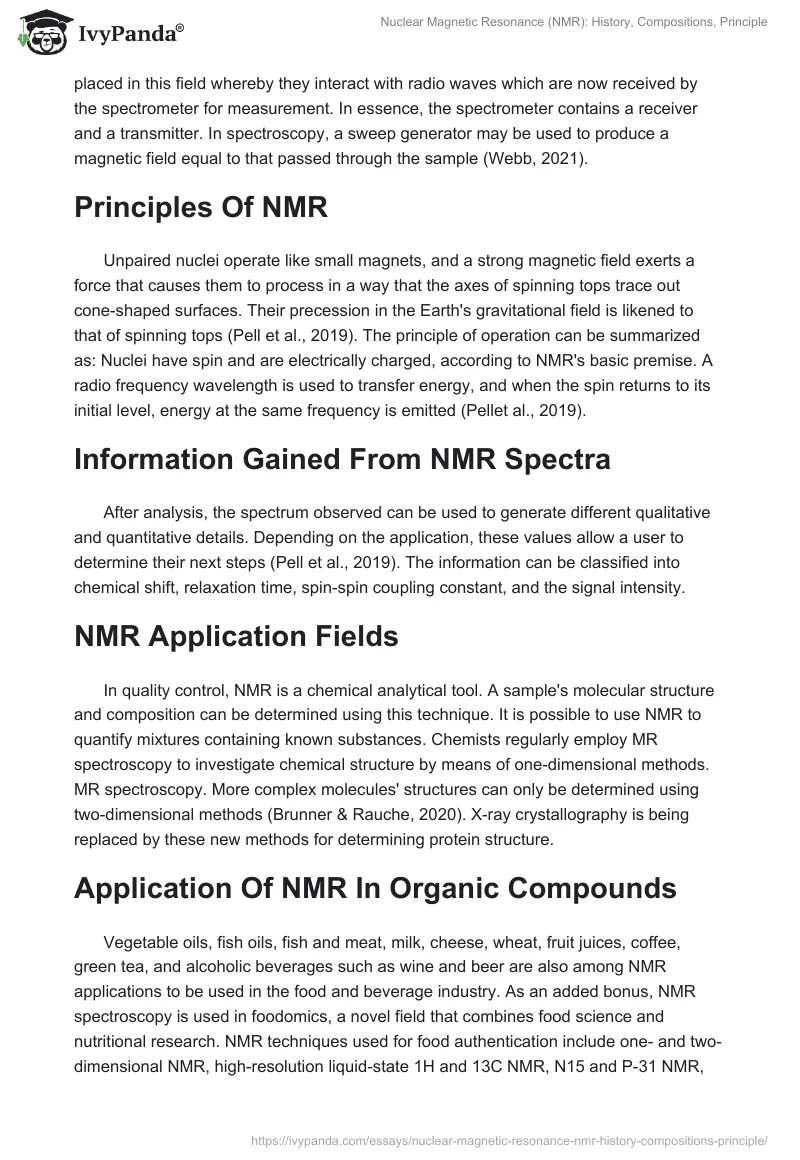Nuclear Magnetic Resonance(NMR)
NMR is a common term in spectroscopy. It has been applied in many fields, including medicine and analytical chemistry. The main elements that constitute the definition of NMR include a magnetic field (strong and stationary) and an oscillating magnetic field (Pell et al., 2019). The interaction of the two magnetic fields perturbs the stationary field causing it to respond by producing an electromagnetic signal. This phenomenon is based on the selective absorption principle that has found application in the separation of elements in analytical chemistry.
NMR History
In 1938, Columbia University’s I. I. Rabi used magnetic resonance absorption of molecular beams to accurately detect nuclear magnetic moments (and was awarded the Nobel Prize in Physics in 1944 for his work). NMR was born in 1946 when F. Block and E. M. Purcell successfully showed it in condensed matter (and shared the Nobel Prize in Physics in 1952).
In 1950, scientists discovered that the chemical bonding status of atoms caused minor changes in the atomic nucleus Larmor frequencies (chemical shift and spin coupling). Thus, nuclear magnetic resonance (NMR) spectroscopy was conceived as a way to examine and identify materials using nuclear magnetic resonance (NMR) (Brunner & Rauche, 2020).
NMR Instrument Composition
NMR measurements are made in the spectrometer when the radio-frequency waves are received and transmitted. Lastly, the superconducting magnet plays the role of magnetic field generation. The magnetic field generated here is estimated to be thousands of times stronger than the Earth’s magnetic field. The test samples are placed in this field whereby they interact with radio waves which are now received by the spectrometer for measurement. In essence, the spectrometer contains a receiver and a transmitter. In spectroscopy, a sweep generator may be used to produce a magnetic field equal to that passed through the sample (Webb, 2021).
Principles Of NMR
Unpaired nuclei operate like small magnets, and a strong magnetic field exerts a force that causes them to process in a way that the axes of spinning tops trace out cone-shaped surfaces. Their precession in the Earth’s gravitational field is likened to that of spinning tops (Pell et al., 2019). The principle of operation can be summarized as: Nuclei have spin and are electrically charged, according to NMR’s basic premise. A radio frequency wavelength is used to transfer energy, and when the spin returns to its initial level, energy at the same frequency is emitted (Pellet al., 2019).
Information Gained From NMR Spectra
After analysis, the spectrum observed can be used to generate different qualitative and quantitative details. Depending on the application, these values allow a user to determine their next steps (Pell et al., 2019). The information can be classified into chemical shift, relaxation time, spin-spin coupling constant, and the signal intensity.
NMR Application Fields
In quality control, NMR is a chemical analytical tool. A sample’s molecular structure and composition can be determined using this technique. It is possible to use NMR to quantify mixtures containing known substances. Chemists regularly employ MR spectroscopy to investigate chemical structure by means of one-dimensional methods. MR spectroscopy. More complex molecules’ structures can only be determined using two-dimensional methods (Brunner & Rauche, 2020). X-ray crystallography is being replaced by these new methods for determining protein structure.
Application Of NMR In Organic Compounds
Vegetable oils, fish oils, fish and meat, milk, cheese, wheat, fruit juices, coffee, green tea, and alcoholic beverages such as wine and beer are also among NMR applications to be used in the food and beverage industry. As an added bonus, NMR spectroscopy is used in foodomics, a novel field that combines food science and nutritional research. NMR techniques used for food authentication include one- and two-dimensional NMR, high-resolution liquid-state 1H and 13C NMR, N15 and P-31 NMR, and 1H HR/MAS (high-resolution magic angle spinning) NMR (Webb, 2021). These techniques are all based on nuclear magnetic resonance.
Evaluation Of Complex Food Substances Through NMR
The chemical composition of food is determined using high-resolution NMR spectroscopy applied to semi-solid food samples or extracted components in solution (Pell et al., 2019). As a reliable approach for analyzing mixtures at the molecular level, nuclear magnetic resonance spectroscopy (NMR) is well-suited for food science applications because it doesn’t necessitate separation or purification stages. Although NMR is becoming increasingly popular among food scientists, it is still an underutilized technology because of its expensive cost, low sensitivity, and the fact that many food scientists lack NMR knowledge (Pell et al., 2019).
NMR Application in the Study of Liposomes
Lipid clumps called liposomes are well-known. Using liposomes, researchers may tweak their lipid makeup and size. Liposome size and bilayer structure are influenced by the synthesis process, lipid composition, temperature, and pH. Liposomes’ physicochemical features make them useful in a wide range of situations (Brunner & Rauche, 2020). Liposome characteristics can be studied using a variety of techniques, including nuclear magnetic resonance (NMR). The method’s strengths include its great sensitivity and excellent resolution. In addition, it offers data on molecular dynamics and structure.
Conclusion
NMR is a common term in spectroscopy. It has been applied in many fields, including medicine and analytical chemistry. The main elements that constitute the definition of NMR include a magnetic field (strong and stationary) and an oscillating magnetic field. As a reliable approach for analyzing mixtures at the molecular level, nuclear magnetic resonance spectroscopy (NMR) is well-suited for food science applications because it does not necessitate separation or purification stages.
References
Brunner, E., & Rauche, M. (2020). Solid-state NMR spectroscopy: an advancing tool to analyze the structure and properties of metal–organic frameworks. Chemical Science, 11(17), 4297-4304.
Pell, A., Pintacuda, G., & Grey, C. (2019). Paramagnetic NMR in solution and the solid state. Progress In Nuclear Magnetic Resonance Spectroscopy, 111, 1-271.
Webb, G. (2021). Annual Reports on NMR Spectroscopy. Elsevier Science & Technology.


